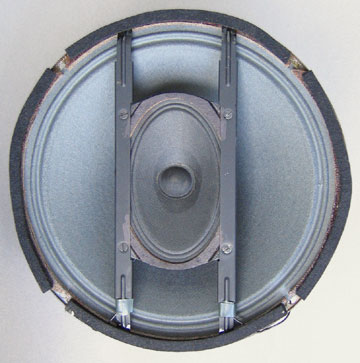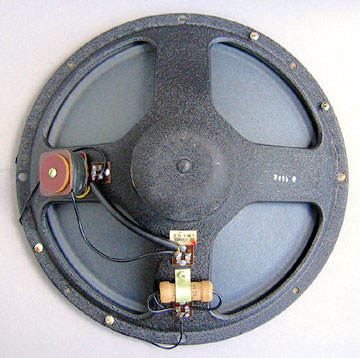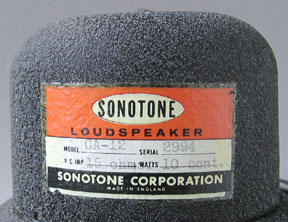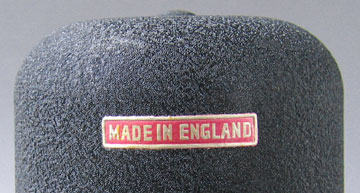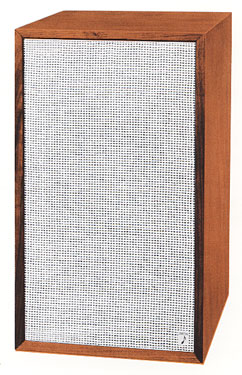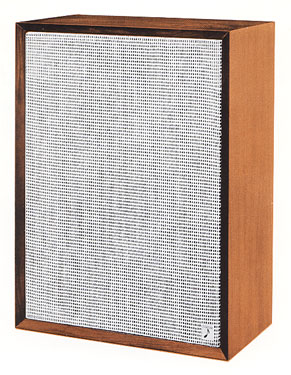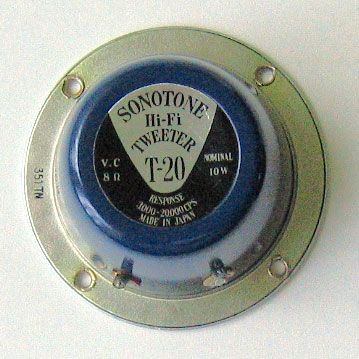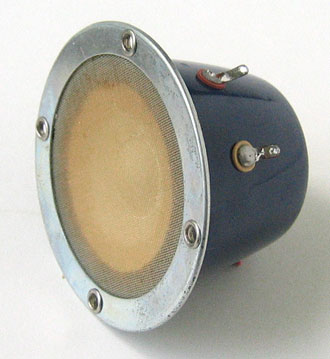Sonotone Speaker History
By Roger Russell
These
pages are copyrighted.
No portion of this site may be reproduced in whole or in part
without written permission of the author.
What is on this page?
![]()

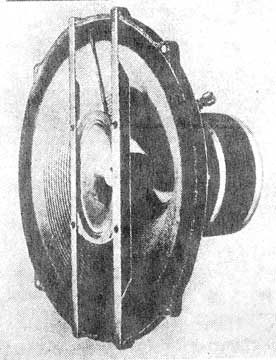 Sonotone had been selling loudspeakers for a few years
before I started working there. They had been buying drivers from Plessey of
England and putting the Sonotone name on them. In 1956, a complete system was
available called the Sonotone 220 Loudspeaker System. It incorporated the CA-15
that was a 15" coaxial driver with an integral crossover network. It had a
5-lb. Alnico magnet with 15,000 gauss flux density. The woofer frame was an
aluminum casting. The cone was a special curvilinear type with annular ring
corrugations. The voice coil had a 5/8 long winding. Voice coil forms in both
drivers were aluminum
Sonotone had been selling loudspeakers for a few years
before I started working there. They had been buying drivers from Plessey of
England and putting the Sonotone name on them. In 1956, a complete system was
available called the Sonotone 220 Loudspeaker System. It incorporated the CA-15
that was a 15" coaxial driver with an integral crossover network. It had a
5-lb. Alnico magnet with 15,000 gauss flux density. The woofer frame was an
aluminum casting. The cone was a special curvilinear type with annular ring
corrugations. The voice coil had a 5/8 long winding. Voice coil forms in both
drivers were aluminum
The woofer also has an unusual velour suspension that drops resonance to 30 cycles and keeps extreme lows full, rich and natural. The six-inch by four-inch non-metallic cone tweeter is elliptical, providing wide lateral dispersion of highs without tininess or piercing effect. The linear output is from 20 to 17,000 cycles and power handling of 25 watt average and 40 watt peak.
The 220 system is not a bass reflex type. The enclosure is sealed and the back wave is completely absorbed in the enclosure. The enclosure had internal damping in the cabinet that is unique, using vertical strips of felt, each with a progressively smaller hole in the center as the strips go further back from the woofer. The system sold for $199.00 and was available in mahogany, Blonde or fruitwood finish. Woofer and tweeter were also available separately.
|
Specifications |
W-15 woofer |
T-64 tweeter |
|
Response |
20-7000 cycles |
2000-17,000 cycles |
|
Power input |
25 watt continuous |
10 watts above 2kc |
|
Resonant frequency |
30 cycles |
|
|
Impedance |
15 ohms |
15 ohms at 10 kc |
|
Voice coil diameter |
2 |
3/4 |
|
Flux density |
15,000 gauss |
12,000 gauss |
|
Total flux |
228,000 lines |
|
|
Magnet |
5-lb. Alnico |
|
|
Suspension |
Cloth velour |
|
|
Size |
16 diameter |
6 X 4 |
|
Weight |
20 lbs. |
1 lb. 5 oz. |
|
Price |
$78.00 |
$7.50 |
![]()
In 1957 Sonotone introduced the 110 speaker system that included the CA-12 12" coaxial speaker with an integral crossover network and having a 6 X 4" elliptical tweeter. This speaker could be purchased separately for $21.00 and a separate woofer for $13.50.
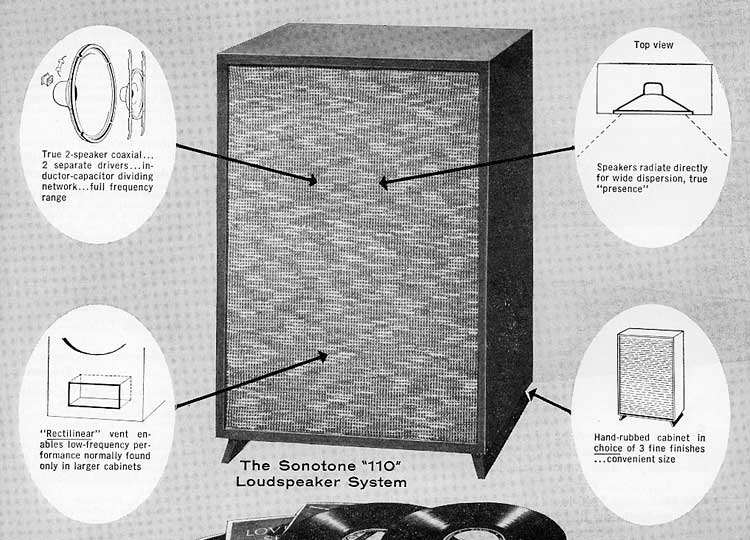
|
Speaker |
CA-12 12 coaxial |
|
Power handling |
10 watts |
|
Frequency range |
40-14.000 cycles |
|
Resonant frequency |
50 cycles |
|
Crossover frequency |
2000 cycles |
|
Impedance |
15 ohms |
|
Woofer Flux density |
12,000 gauss |
|
Tweeter flux density |
8500 gauss |
|
Cabinet size |
30H, 20W, 14D |
|
Weight |
Approximately 50 lbs. |
|
Price |
$79.50 |
![]()
|
|
|
|
Two metal brackets are used to hold the elliptical tweeter. The 1.3 mH series woofer crossover coil is located on the back of the basket at the left in the picture and the 2 mfd series tweeter capacitor is shown at the bottom. These comprise a 6dB/octave crossover. Like the CA15, the magnet is Alnico but the basket is made of stamped steel and finished with black wrinkle paint. Although the speaker was made in England, a Sonotone decal was attached to the side of the magnet structure. The accordion surrounds of both woofer and tweeter are a continuation of the paper cones. Felt pieces around the front rim of the woofer are for mounting from inside the cabinet. Later production was changed to a brown metallic enamel finish. |
|
|
|
|
![]()
WR-8 Wide-Range Speaker
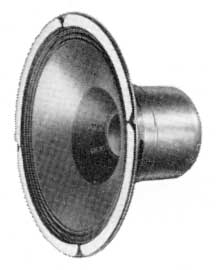
An 8-inch speaker made by Plessey was introduced in 1958. This also has an Alnico magnet and a brown metallic enamel finish. The accordion surround is a continuation of the paper cone.
|
Frequency range |
55 to 15,000 cycles |
|
Resonant frequency |
65 cycles |
|
Power input |
8 watts |
|
Impedance |
8 ohms |
|
Flux density |
12,000 gauss |
|
Voice coil diameter |
1 inch |
|
Price |
$12.00 |
![]()
 Here is a picture of Leonard Kane, the advertising
manager at Sonotone. This picture is part of an ad for the Sonotone-Plessey
CA-12 coaxial loudspeaker and appeared in the March 1957 issue of Audio magazine.
Employees were sometimes used in advertising Sonotone products.
Here is a picture of Leonard Kane, the advertising
manager at Sonotone. This picture is part of an ad for the Sonotone-Plessey
CA-12 coaxial loudspeaker and appeared in the March 1957 issue of Audio magazine.
Employees were sometimes used in advertising Sonotone products.
A complete line of Sonotone speaker systems was needed in addition to the separate drivers. It became obvious that cabinets could be purchased locally and assembled into complete systems by Sonotone at a much lower cost compared to the cost of shipping complete speaker systems from England.
![]()
I started working for Sonotone after graduating from college in June 1959. Before starting the design of new systems, however, my first project was to locate and set up equipment for A-B listening tests for both cartridges and speakers. Instant switching was needed for accurate listening comparison. I used a Harman-Kardon Citation I preamp and installed a small relay inside to switch the phono inputs. Using a latching relay to drive the small switching relay, a push button switch could be used to change from A to B each time the button was pushed. I also added controls to match the listening level. A pair of McIntosh MC60's was used for power amplifiers.
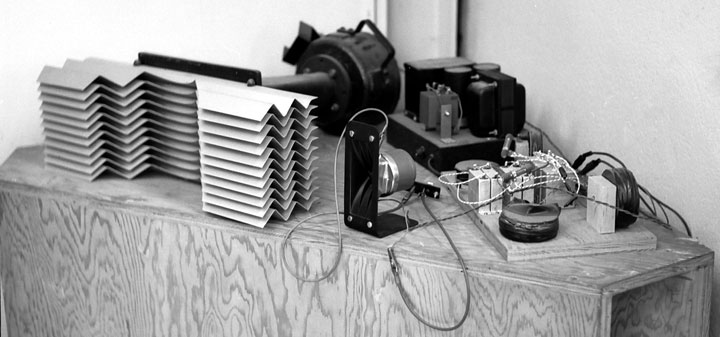
The speakers were unique. Dual low frequency corner horn enclosures were available. They had been designed by Arnold Stein and built for the lab but had been unused and in storage. Each cabinet used two JBL D130 15" woofers and were located in the corners of the lisetning on the long wall. The mid-ranges were Western Electric 594 drivers, the first 4" voice coil driver on the market. They were coupled to a JBL horn and lens assembly.
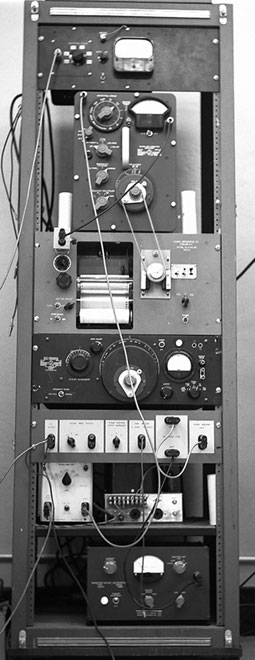 The drivers had field coils and required a DC power
supply. Response went very smoothly out to 10kHz. An Electro-Voice T-35 was
used to extend the response. I sometimes used a center channel speaker having a
much-reduced level in mono.
The drivers had field coils and required a DC power
supply. Response went very smoothly out to 10kHz. An Electro-Voice T-35 was
used to extend the response. I sometimes used a center channel speaker having a
much-reduced level in mono.
The listening room had no absorbing surfaces except a carpet on the floor. Dimensions were approximately 20' by 15' and 10 feet high. 24" wide strips of 3/4" thick felt were hung a few inches from the walls. This made a big improvement in the listening conditions.
The listening room was also used as the room to make speaker response curves. I used a rack full of test equipment shown at the right. From top to bottom the test equipment is a Ballantine AC voltmeter that had a linear dB scale, General Radio 1554 sound and vibration Analyzer (a battery operated unit later replaced with the smaller 1554A that had rechargeable batteries), Sound Apparatus chart recorder, General Radio 1304 oscillator, switching & patch panel, Keithly decade amplifier, McIntosh MC30 a 30 watt power amplifier and General Radio 1390 white/pink noise generator.
General Radio had just come out with a new method of testing speakers using the 1554 sound and vibration analyzer and pink noise. Broadband pink noise was fed to the speaker, picked up by an Altec M-20 condenser microphone and sent to the continuously variable 1/3 octave filter.
The 1554 could be chain driven by the chart recorder and response automatically plotted. Compared to the sine wave measurements, this greatly reduced the influence of multiple reflections and standing waves in the listening room. The oscillator could also be chain driven by the chart recorder for automatic plots.
A large Tektronix oscilloscope and cart was also available to use for phase checks, etc. Yes, thats me about 1962. To play records we used a Rek-O-Kut turntable with several Rek-O-Kut tonearms mounted around it.
![]()
The New 8 Wide-Range Speaker WR-8BH
 Development of the new Sonotone speakers began in 1962.
I decided that drivers could be made to our specifications from American
vendors as well the cabinets. Fred Becker of Becker Electronics had an office
in Valley Stream, Long Island and a speaker manufacturing plant in East Durham,
NY. The first driver that I developed with John Tiedje at Becker was an 8"
wide range unit.
Development of the new Sonotone speakers began in 1962.
I decided that drivers could be made to our specifications from American
vendors as well the cabinets. Fred Becker of Becker Electronics had an office
in Valley Stream, Long Island and a speaker manufacturing plant in East Durham,
NY. The first driver that I developed with John Tiedje at Becker was an 8"
wide range unit.
A small concentric cone, called a whizzer, is used to extend smooth high frequency response beyond 15kHz. The efficiency is relatively high and very little power is needed for a good listening level. An alnico magnet is used and a decorative magnet cover is attached to the back of the basket. It is known as the WR-8BH. The driver is used in the Scarsdale and Beverly Hills systems.
|
Frequency Response |
45 to 20,000 cycles per second |
|
Power Handling |
20 watts average programming, 40 watts peak |
|
Impedance |
8 ohms |
|
Terminal connections |
Color coded binding posts, twist type |
|
Dimensions |
8 diameter and 4-1/4 deep |
|
Speaker frame finish |
Cadmium plated |
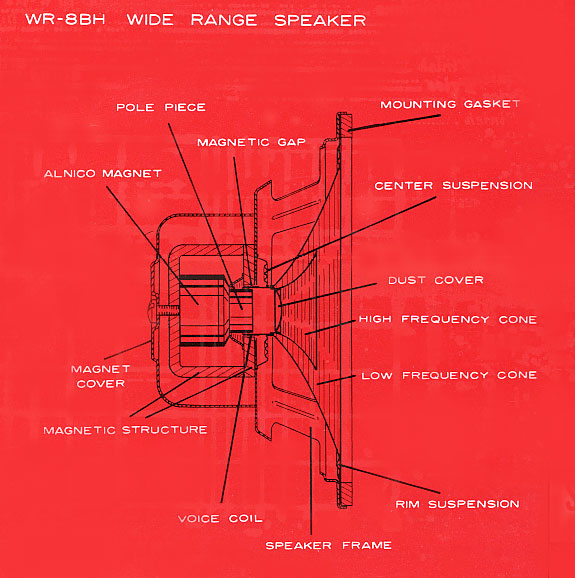
![]()
Scarsdale and Beverly Hills Systems
|
|
|
The Scarsdale (left) and Beverly Hills (right) are both vented systems. One WR-8BH is used in the Scarsdale and two are used in the Beverly Hills. The cabinets are made of 3/4 high density particle board and corners are lock-miter joints. The finish is hand-rubbed walnut veneer. Tufflex acoustic material lines the inside of the cabinets. A special acoustic resistance material is used at the entrance to the vent to eliminate annoying boominess often found in many vented systems.
|
Specifications |
Scarsdale SE-80 |
Beverly Hills SE-880 |
|
Response |
45 to 20,000 cps |
45 to 20,000 cps |
|
Power handling |
20W average, 40W peak |
40W average, 80W peak |
|
Impedance |
8-ohms |
8 to 16 ohms |
|
Terminals |
Color coded binding |
Color coded binding |
|
Drivers |
Single 8 |
Two 8 |
|
Size |
20-1/2 H, 12-1/2W, 11-1/2D |
24H, 17-1/2W, 11D |
|
Weight |
27 lbs |
36 lbs |
|
Finish |
Oiled walnut |
Oiled walnut |
|
Price Oct. 1964 |
$49.75 |
$69.75 |
![]()
New Drivers for Sealed Systems

A new line I called the RM series was next. I was enthusiastic about the new acoustic principle that Ed Villchur had developed at Acoustic Research. I visited with him in Cambridge, MA and obtained two woofers to use for evaluation. The result was several woofers developed with Becker to be used in sealed systems. Shown above are the 4, 6 and 8 linear high compliance drivers. The Becker-Sonotone drivers were called the HC-40, HC-60 and HC-80. The 4 and 6 drivers have a ceramic magnet and the 8 driver has an Alnico magnet.
![]()
RM-1 Sonomaster Speaker System
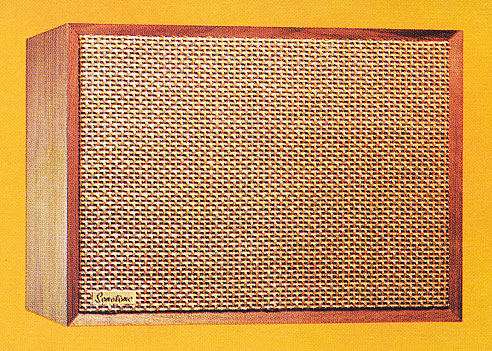
|
Response |
45 to 20,000 cps |
|
Power handling |
40W average, 80W peak |
|
Impedance |
8 ohms |
|
Terminals |
Screwdriver |
|
Drivers |
6 woofer, 2 tweeter |
|
Crossover frequency |
5000 cps |
|
Size |
14-1/2H, 10-1/2W, 7-1/4D |
|
Weight |
12 lbs |
|
Finish |
Oiled walnut |
|
Price October 1964 |
$42.50 |
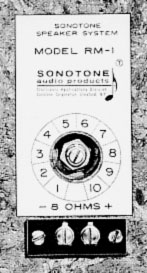 A high frequency level control is located at the back of the system. A
screw driver or even a finger nail can turn it. An angled portion of the shaft
points to the correct number. The cabinets can be used standing up or laying on
their side. The Sonotone logo can be rotated so that it is always horizontal.
In the left advertising picture is an RM-1 and Jean, a secretary in the battery
division.
A high frequency level control is located at the back of the system. A
screw driver or even a finger nail can turn it. An angled portion of the shaft
points to the correct number. The cabinets can be used standing up or laying on
their side. The Sonotone logo can be rotated so that it is always horizontal.
In the left advertising picture is an RM-1 and Jean, a secretary in the battery
division.
The RM-1 was the first of the two-way sealed systems and incorporated the 6 woofer. The 2cone tweeter is the MT20HFC made by Royal Copenhagen, later known as Peerless of Denmark. A later version of the RM-1 has a Matsushita EAS-65PH09SB2" cone tweeter. It is a better match with the 6" woofer.
|
|
|
The Matsushita tweeter is sealed with a metal cup in the back so that pressure from the woofer will not drive the tweeter cone. A plastic screen is in front of the cone for protection. This tweeter is also used in later versions of the RM-1 system as well as the RM-1K, RM-2 and RM-0.5. I wrote an instruction book for each system.
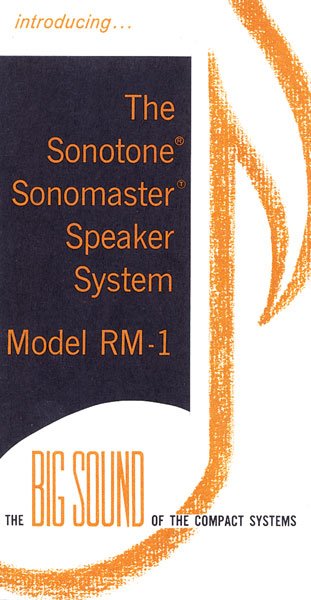
![]()
RM-1K Sonomaster Speaker System Kit
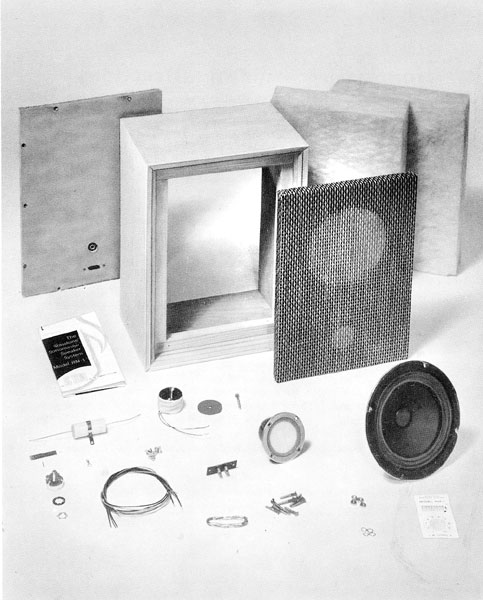
The RM-1 was very successful and a kit version was also introduced called the RM-1K. I wrote a 14-page assembly manual to go with it. The picture shows the Japanese Matsushita tweeter and the parts needed to assemble the kit. It was reviewed favorably in Popular Science magazine. Two pieces of pre-cut fiberglass are used as acoustic material and two latex gloves are included to handle it. By the time the manual and packaging of all parts were completed, the price of the kit was almost the same as the completely assembled system. In addition, finishing of the cabinet was left to the buyer. The performance specifications are the same as the RM-1 production system.
![]()
RM-2 Sonomaster Speaker System
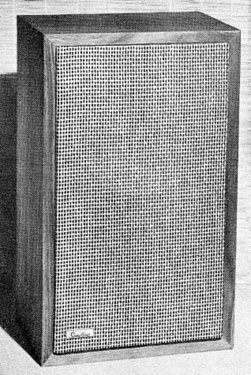
Following the success of the RM-1 and RM-1K, the RM-2 was introduced
|
Response |
40 to 20,000 cps |
|
Power handling |
50W average, 100W peak |
|
Impedance |
8 ohms |
|
Terminals |
Screwdriver |
|
Drivers |
8 woofer, 3-1/2 tweeter |
|
Crossover frequency |
4500 cps |
|
Size |
19H, 11-1/2W, 8-1/2D |
|
Weight |
22 lbs. |
|
Finish |
Oiled walnut |
|
Price October 1964 |
$56.50 |

![]()
RM-0.5 Sonomaster Speaker System
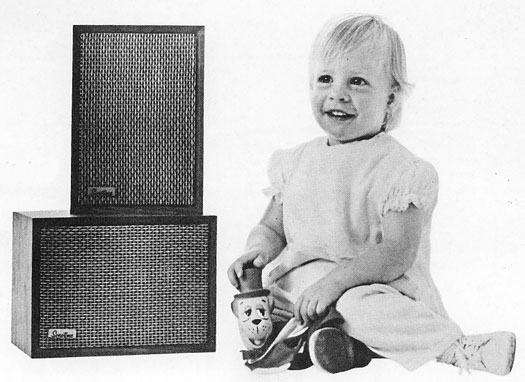
|
Response |
55 to 20,000 cps |
|
Power handling |
20W average, 40W peak |
|
Impedance |
8 ohms |
|
Terminals |
Screwdriver |
|
Drivers |
4 woofer, 2 tweeter |
|
Crossover frequency |
5000 cps |
|
Size |
10-1/2H, 7-1/2W, 7D |
|
Weight |
9 lbs. |
|
Finish |
Oiled walnut |
|
Price October 1964 |
$39.75 |
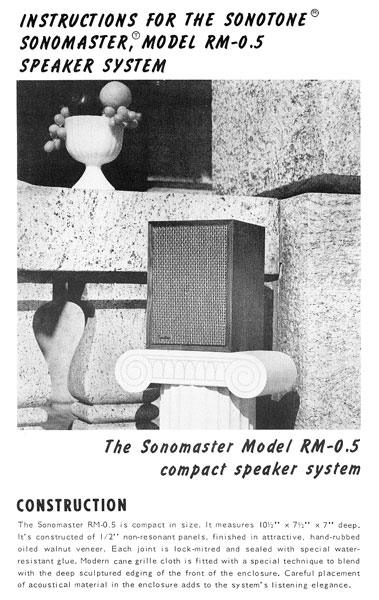
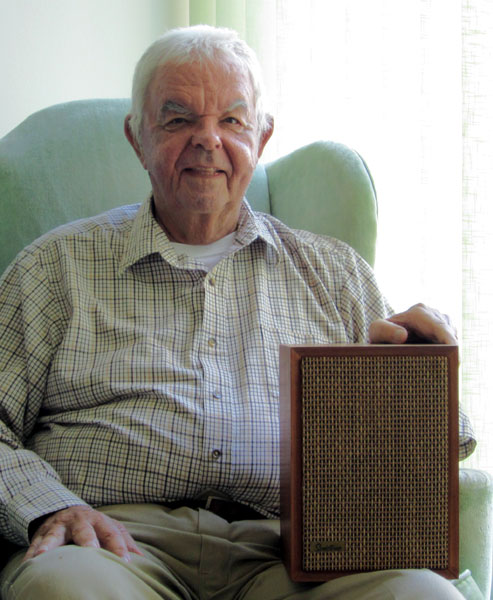
Almost 50 years later, I found a pair of RM-0.5 speakers that I had designed. They are in excellent condition.

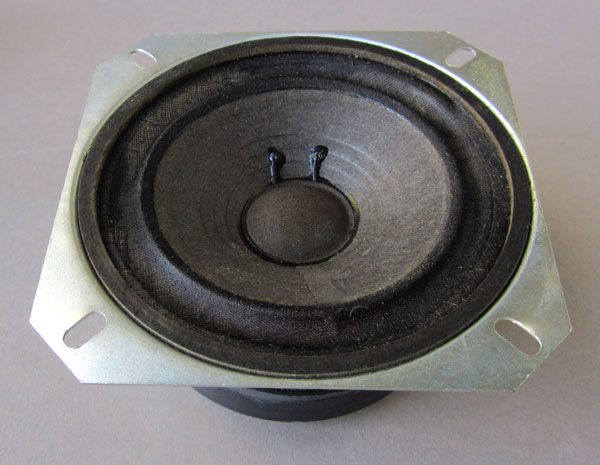
Becker, our American driver supplier, had never made such a small driver before. A 4 woofer was a new adventure for both John Tiedje and me. Tiny woofers were not common in those days. A longer excursion is required to effectively reproduce any bass at all. The surround is made of treated cloth in an inverted half-roll. This allows for longer cone excursions. The woofer is still in excellent condition and works very well despite its age.
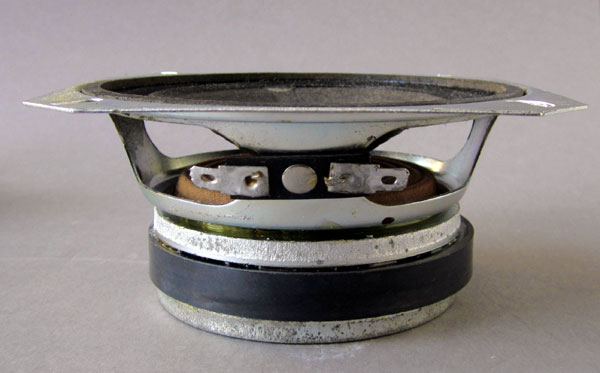
A large magnet structure is required to provide enough flux in the gap to compensate for the greater voice coil winding height. A dot is shown next to the positive connecting terminal.
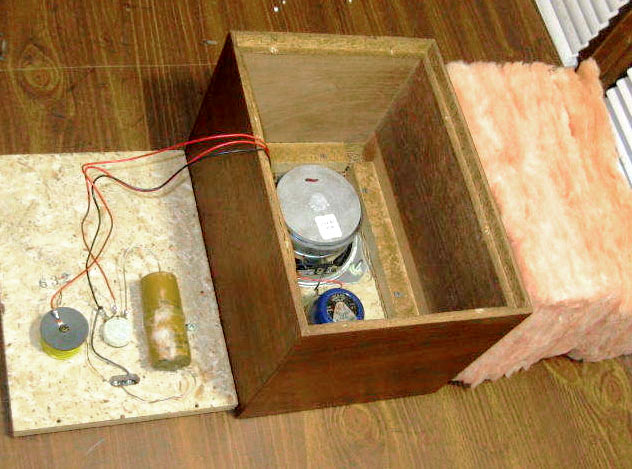
The enclosure is filled with several layers of fiberglass. The crossover network is a simple 6dB type using one series coil with the woofer and one capacitor in series with the tweeter. A control is added to adjust the level of the tweeter. A Matsushita tweeter, previously discussed, is used to complement the woofer. Both drivers are mounted in recessed cutouts in the front board. The cabinet is made of 3/4 particle board and veneered with an oiled walnut finish.
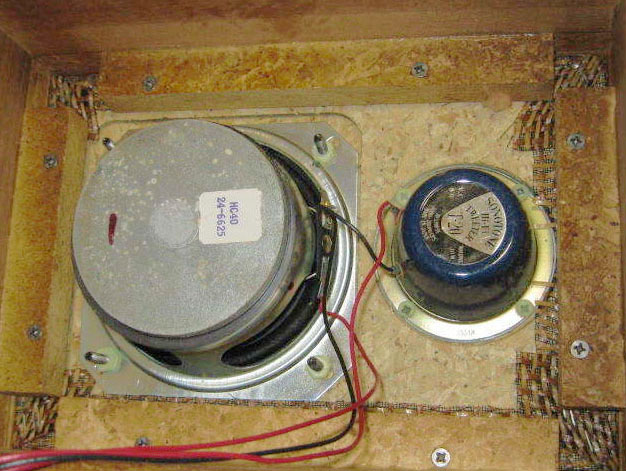
The grille cloth is mounted to the front board and the board is held in place with screws through inside cleats.
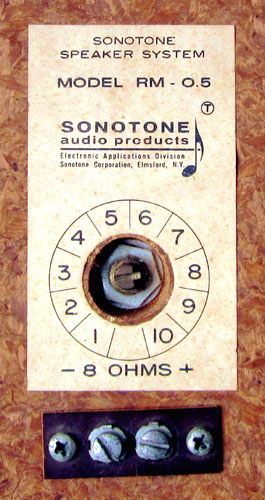
![]()
Near the time I left Sonotone, in 1967, I had developed a three-way RM-3 system. This included a 12" woofer, a 6" mid and a 2" tweeter. It never went into production, and Sonotone speaker products were discontinued the next year.
During my employment at Sonotone, I was not only involved with loudspeaker design but also with microphone design. In addition, I began writing magazine articles. In 1961 I worked with Phil Kantrowitz to make the measurements and writing his paper for the 13th AES Convention titled "Distortion Measurements of High Frequency Loudspeakers"
Encouraged by Roland Gray, who worked for Leonard Kane in the Sonotone advertising department, I wrote my first article. Roland knew Oliver Ferrell, the editor of Popular Electronics magazine, and had found there was interest in a volume compressor-expander that I had designed. The article was titled "Build a Hi-Fi Volume Compressor-Expander" and was published in the October 1964 issue of Popular Electronics. It was also published in fall 1965 issue of The Electronic Experimenter's Handbook. In 1966 I wrote an article for Electronics World titled "Enclosures for High Compliance Loudspeakers" based on my work in designing the Sonotone line of RM speaker systems.
I spent a day with Abe Cohen making tests on his Bi-Phonic Coupler loudspeaker system. Abe had written an article titled The Wood Panel That Talks and was published in Audio Magazine, March 1960. Abe was president of his company, Advanced Acoustics, Inc., 67 E. Centre Street, Nutley 10, N.J..
Early in 1967, the CTS sales representative, Bernie Beck told me that there was an opening at McIntosh Laboratory for a speaker designer. At that time McIntosh had sent a letter to members of the Audio Engineering Society advertising for design engineers at McIntosh. Speaker design was not included, but Bernie said I should call. It seems Bernie had been in touch with Sidney Corderman about selling speaker mechanisms to McIntosh and also about a speaker system designed by Ed Long at CTS. Ed had just presented a paper at the AES about his system. Bernie knew Sidney was looking for someone to start a speaker line for McIntosh. I called and spoke with Mr. Corderman who was Vice President in charge of engineering. I interviewed with him in February. A few days later he called and made an offer and I started work at McIntosh in March of 1967.
Detailed List of Sonotone Speaker Systems
Sonotone-Plessey Speaker Systems
110 Speaker system. vented, acoustically damped. Mahogany, blonde and fruitwood. Contains Plessey CA-12 coaxial speaker. Response 40-14kHz. Power 10w continuous, 20w peak. Impedance 15 ohms. Crossover 2kHz. 1957 Price $79.50
220 Speaker system. Sealed, acoustically damped. Mahogany, blonde and fruitwood. Contains Plessey CA-15 coaxial speaker. Response 20-17kHz. Power 25w continuous, 40w peak. Impedance 15 ohms. Crossover 2kHz. 1956 Price $199.00
Sonotone-Becker Speaker Systems
SE-80 "The Scarsdale" Bass reflex bookshelf system. Walnut. 8" wide range dual cone driver. Response 45-20kHz. Power 20w avg, 40w peak. Impedance 8 ohms. Size 20-1/2"H, 12-1/2"W, and 11-1/2"D. Weight 27 lb. Price $49.75
SE-880 "The Beverly Hills" Bass reflex bookshelf system. Walnut. 2-8" wide range dual cone drivers. Response 45-20kHz. Power 40w avg, 80w peak. Impedance 8-16 ohms. Size 24"H, 17-1/2"W and 11-1/2"D. Weight 36 lb. Price $69.75
RM-0.5 Sonomaster speaker system. Walnut. 4" high-compliance woofer and 2" cone tweeter. Response 55-20kHz. Crossover 5kHz. Power 20w average, 40w peak. Impedance 8 ohms. Size 10-1/2"H, 7-1/2"W and 7"D. Weight 8 lb. Price $39.75
RM-1 Sonomaster speaker system. Walnut. 6" high-compliance woofer and 2-1/2" cone tweeter. Response 45-20kHz. Crossover 5kHz. Power 40w average, 80w peak. Impedance 8 ohms. Size 14-1/2"H, 10-1/2"W and 7-1/4"D. Weight 12 lb. Price $44.50
RM-1T Twin pack containing two RM-1 speaker systems. Price $89.00
RM-1K Sonomaster speaker system kit. Same size and specs as RM-1. Unfinished Birch. Detailed assembly manual. 6" high-compliance woofer and 2-1/2" cone tweeter. Response 45-20kHz. Crossover 5kHz. Power 40w average, 80w peak. Impedance 8 ohms. Size 14-1/2"H, 10-1/2"W and 7-1/4"D. Weight 12 lb. Price $35.50
RM-2 Sonomaster speaker system. Walnut. 8" high-compliance woofer and 3-1/2" cone tweeter. Response 40-20kHz. Crossover 4500kHz. Power 50w average, 100w peak. Impedance 8 ohms. Size 19"H, 11-1/2"W and 8-1/2"D. Weight 22 lb. Price $56.50
![]()
[T-64] 6" X 4" elliptical cone tweeter. Impedance 16 ohms. Power handling 20 watts average program. Flux density 12,000 gauss. VC diameter Ύ". VC wire aluminum. Frequency range 2000-20,000Hz. Weight 1lb 5oz. 1961 Price $9.00
[WR-8] 8" wide range speaker. Free air resonance 70Hz. Impedance 8 ohms. Power handling 20 watts average program. Frequency range 55-15,000Hz. 1961 Price $12.00
[W-12] 12" woofer. Free air resonance 50Hz. Impedance 15 ohms. Power Handling 10 watts. Resonant frequency 50Hz. Frequency range 40-7000Hz. 1957 Price $12.00
[W-12] 12" woofer. Free air resonance 50Hz. Impedance 16 ohms. Power Handling 40 watts average program. Flux density 12,000 gauss. Resonant frequency 50Hz. Frequency range 35-7000Hz. 1961 Price $16.00
[CA-12] Coaxial speaker. 12" woofer (same as W-12) and 6" X 4" elliptical cone tweeter. 6dB/oct crossover network at 2000Hz. Free air resonance 50Hz. Impedance 15 ohms. Power handling 10 watts. Resonant frequency 50Hz. Frequency range 40-14,000Hz. 1957 Price $19.50
[CA-12A] Coaxial speaker. 12" woofer (same as W-12) and 6" X 4" elliptical cone tweeter. 6dB/oct crossover network at 2000Hz. Free air resonance 50Hz. Impedance 16 ohms. Power handling 40 watts average program. Woofer flux density 12,000 gauss. Tweeter flux density 9,500 gauss. Resonant frequency 50Hz. Frequency range 35-20,000Hz. 1966 Price $31.00
[CA-15] Coaxial speaker. 15" woofer (same as W-15) and T-64 [6" X 4"] elliptical cone tweeter. Crossover 2kHz. Free air resonance 30Hz. Impedance 15 ohms. 1956 Price $96.00
[W-15] 15" woofer. Response 20-7kHz. Power 25w continuous. Resonance 30Hz. Impedance 15 ohms. VC diameter 2". Flux density 15,000 gauss, Magnet 5lb alnico. Suspension cloth velour. Weight 20 lb. 1956 Price $78.00
Plessey also made an ionophone speaker that we used as a sound source for the design of ultrasonic microphones and speakers for tv remote controls.
![]()
[WR-8BH] 8" Wide range dual cone speaker. Frequency range 45-20kHz. Power 20w average, 40w peak. Impedance 8 ohms. 1966 Price $13.50
[HC-40] 4" High compliance woofer. Response 50-8kHz. Resonance 60Hz. 1966 Price $13.00
[HC-60] 6" High compliance woofer. Response 45-6kHz. Resonance 50Hz. 1966 Price $14.00
[HC-80A] 8" High compliance woofer. Response 40-3kHz. Resonance 30Hz. 1966 Price $16.00
![]()
|
|
|
About This Site |
|
|
|
More text and pictures about Sonotone will be added as my research continues. Any comments, corrections, or additions are welcome. |
|
|
Created
by Roger Russell |
